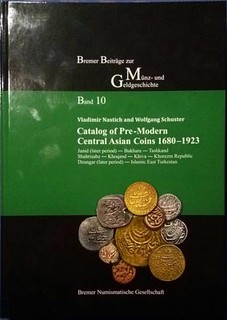
PREV ARTICLE
NEXT ARTICLE
FULL ISSUE
PREV FULL ISSUE
BOOK REVIEW: CENTRAL ASIAN COINS: 1680-1923A new book on pre-modern central Asian coins was reviewed on the Zeno.ru Oriental Coins Database site by by Dick Nauta of the Netherlands. Here's an excerpt. -Editor
Reviewed by Dick Nauta, Dieren, the Netherlands. This work concerns an entirely new Catalog of a field of numismatics that so far has been poorly served by scattered publications of widely varying substance, academic quality and visual impact, not to mention perceptible lack of accessibility. With the present work, the authors have maintained high professional standards in every sense and have succeeded admirably in putting Central Asian coinage on the map, so to say. This publication, an international project, is the result of a fruitful collaboration between a Russian professional orientalist and an Austrian expert numismatist; it took more than ten years to complete. What originally started as a modest but much needed revision of the relevant entries of the SCWC grew into an impressive comprehensive treatise of these coin series. This is not surprising in view of the fact that no compilation of previous work, hailing back to the late 17th century, on any aspect of Central Asian coinages exists. Collecting, selecting and sifting information, translating, critically assessing, separating historical fact from fancy, collating and analysing all that has been published and illustrated in a wide array of periodicals and other scattered documents in archives and museum collections, required the command of about a dozen different languages; this has been the leading author's great merit. The co-author has supported this daunting process by making sense of the information about frequently highly confusing coin types and series, presenting them in as much of a systematic manner as possible. The authors, more than once, acknowledge to have benefited from expert assistance provided by many specialists in related and complementary fields, an indication of the complexity of the topic. It can be said that Central Asian numismatics is not for starters. This is immediately clear from the fact that coin legends may occur in Arabic, Persian, Turkic, Uighur, Russian, Manchu and Chinese, presented in several different scripts, each with a choice of calligraphic renderings, whereas existing literature on these coinages, scattered over time and place, has been published in yet other, different languages. As Dr. Judith Kolbas, the former director of the Central Asian Numismatic Institute (CANI), Cambridge, UK, writes in her professional assessment of this work, this unusual breadth and depth of knowledge has all been rendered into English, so that the Catalog's vast content is now accessible to a very large numismatic community, which in recent years has grown considerably. This Catalog is so far the only resource to cover the historically important transitional period from the late medieval to modern times in the pivotal area of Central Asia, which by its geographic location touches upon numerous adjacent regions, while by its vast extent it was able to maintain its largely pastoral pursuits and related traditions up to the present day. To assist not only the beginner, but also the well-versed numismatist, a very thorough general introductory chapter together with sections on how the catalog has been composed and how to use it make its content readily accessible to all users. All recorded and reported coin types, subtypes, varieties, metal compositions, legends, mint names and their epithets, as well as years of issue are covered and described, together with main design features, latinized readings of coin inscriptions and metrological details as well as physical appearance. Every listing is provided with an estimation of relative rarity using a scheme of six indications from common to exceptionally rare which reflect the catalogers’ personal consideration and experience. Almost all type and variety entries are provided with one or more colored coin illustrations, more than 820 in all. Combining historical facts, basic data and images, the coins themselves almost come to life which makes the catalog easy to use for scholars, museum workers, collectors and coin dealers. To read the complete article, see:
Here's an excerpt of a review from CoinsWeekly. -Editor
There are areas in numismatics that are something for specialists. They have many advantages. One such advantage is that you can always buy extremely rare, interesting and valuable coins below their actual value. For the fewest dealers are specialists in all exotic areas, and so occasionally they don’t notice how rare a coin actually is, because they shun the efforts of searching the literature. The pre-monetary coins of Central Asia are such an area. The fewest coin dealers are able to read their inscriptions in the first place, or know to where and to whom they can be attributed. Or should we better say the fewest dealers knew to where and to which coins of Central Asia can be attributed. For as Volume 10 of its ‘Bremer Beiträge zur Münz- und Geldgeschichte’, the Bremer Numismatische Gesellschaft has published a clearly laid-out catalog that presents the coins from the territory of today’s Kazakhstan, Kyrgyzstan, Tajikistan, Turkmenistan, and Uzbekistan, minted between 1680 and 1923. To read the complete CoinsWeekly review, see:
Here's the publisher's information. -Editor
For 20 years now, the Bremen Numismatic Society has published books with topics on numismatics. This year, Band 10 was released as an international band in English. Already our band 8 was written in English in English and a great success. It is equally pleasing to be able to support with the newly published book, for the first time international authors - Vladimir Nastich from Moscow and Wolfgang Schuster from Austria . Volume 10:
For more information, or to purchase, see:
 Wayne Homren, Editor The Numismatic Bibliomania Society is a non-profit organization promoting numismatic literature. See our web site at coinbooks.org. To submit items for publication in The E-Sylum, write to the Editor at this address: whomren@gmail.com To subscribe go to: https://my.binhost.com/lists/listinfo/esylum All Rights Reserved. NBS Home Page Contact the NBS webmaster 
|
